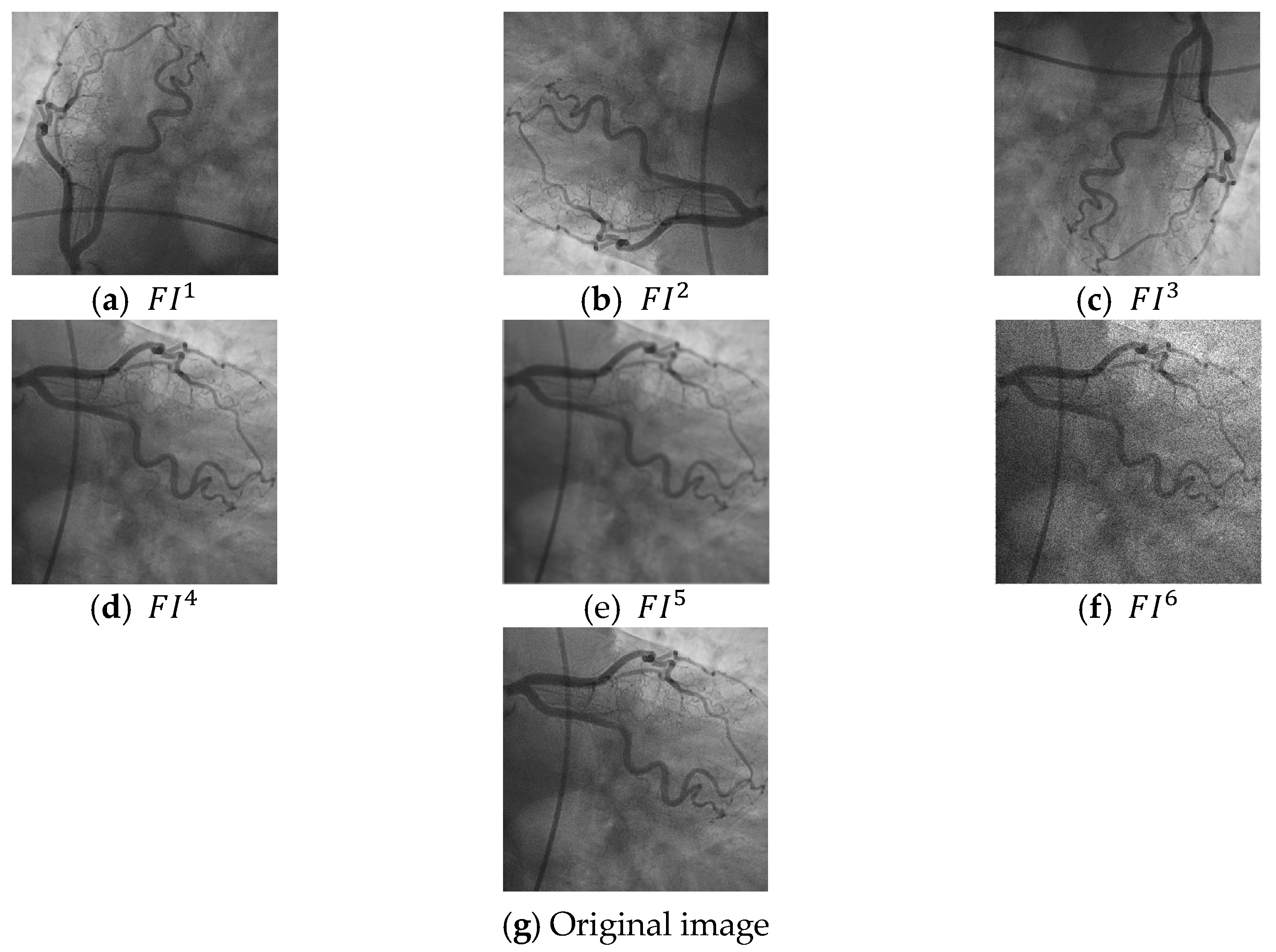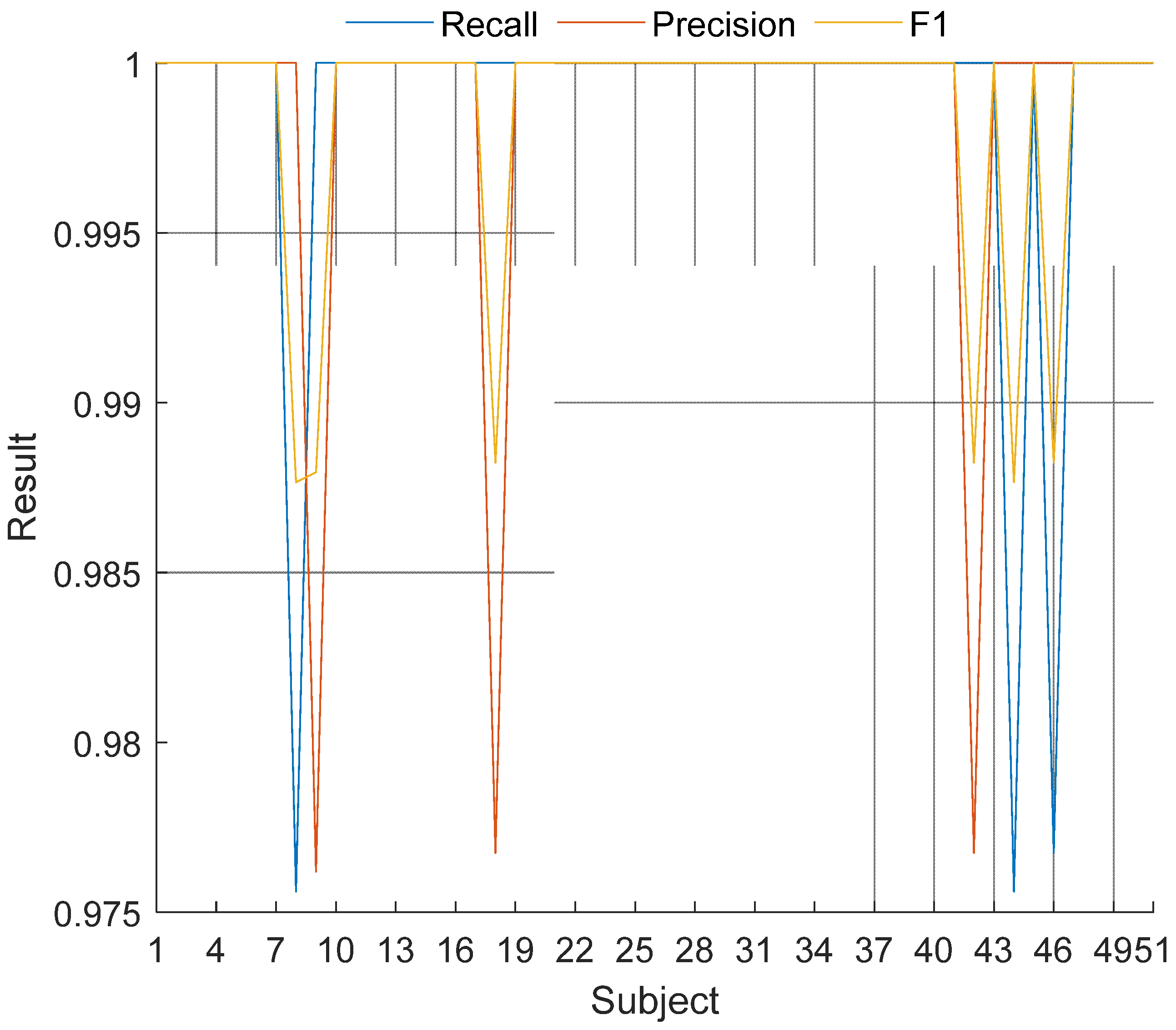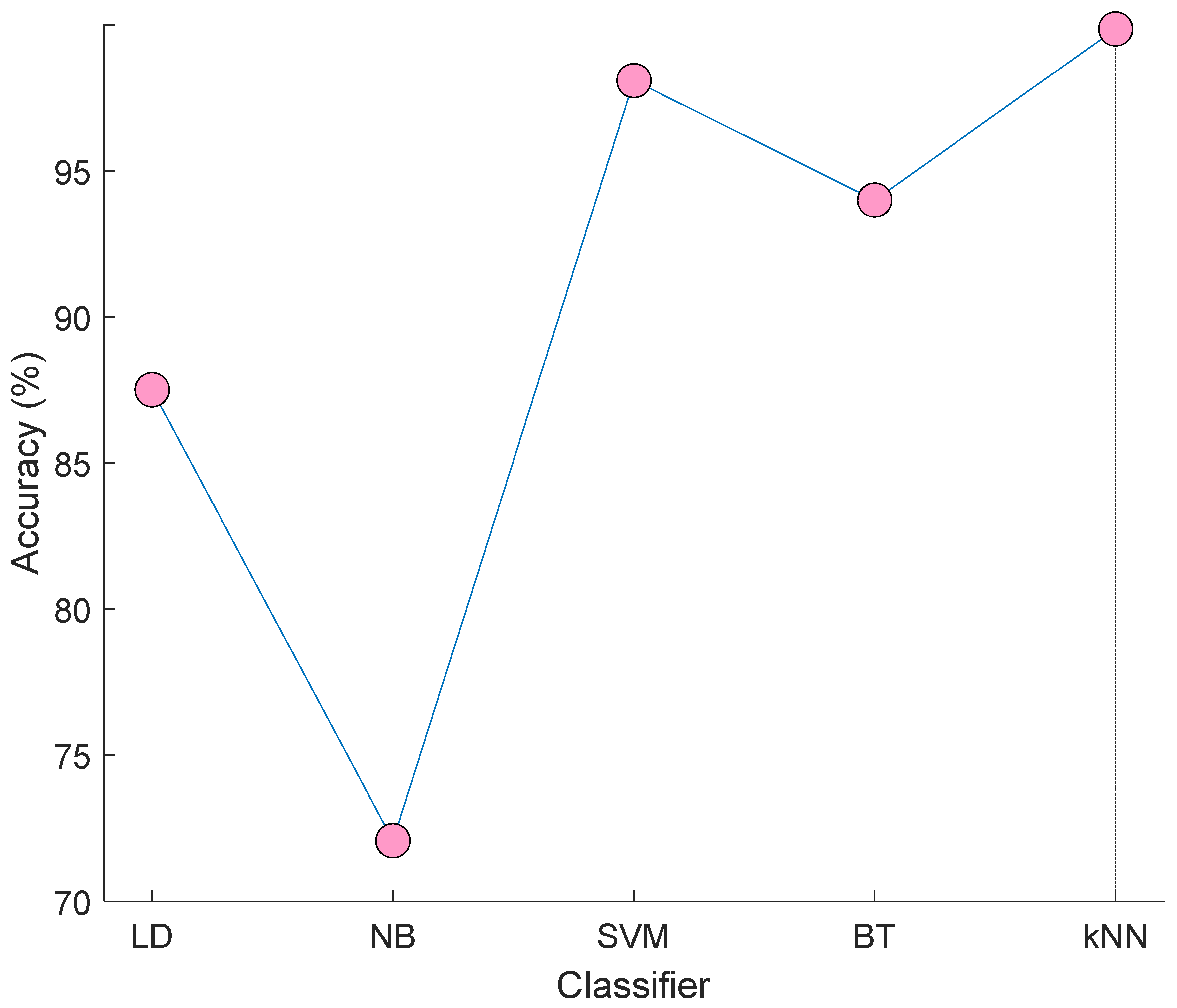Coronary Angiography Print: An Automated Accurate Hidden Biometric Method Based on Filtered Local Binary Pattern Using Coronary Angiography Images
Abstract
1. Introduction
- Hidden biometrics is one of the popular research issues. This work contributes to the hidden biometrics research area and we investigated new biometric features in this work. To validate the human identification feature of the coronary artery images, a novel coronary angiography image database was collected and published publicly (see Section 2).
- An accurate image classification model is presented using an LBP feature extractor. LBP is an effective feature generator and it has commonly been used in biometrics methods. To increase the feature extraction capability of the LBP, a multileveled and filtered extractor is presented. Moreover, NCA chooses the top features and kNN classifies the selected features. This model attained a 99.86% accuracy rate on the collected database. Furthermore, our proposal can be used in other image classification problems.
2. Materials and Methods
2.1. Material
2.2. Method
2.2.1. Preprocessing
2.2.2. Feature Extraction Using Local Binary Pattern
2.2.3. Feature Selection Based on Neighborhood Component Analysis
2.2.4. Classification
3. Results and Discussions
- A new hidden-biometric feature is presented using coronary angiography images.
- To validate the results of the proposed coronary angiography images based on biometric identification, a new large database was collected and it is published publicly.
- A new LBP-based human identification approach is proposed in this work and this approach resulted successfully. Our proposed model can extract features at a high level by using filters and multi-level maximum pooling decomposition. By only using the LBP extractor, low-level features are extracted. Herein, we used a filtered-LBP to create features at a high level. Moreover, we have used an effective feature selector (NCA) to increase the performance of the proposed model.
- The proposed filtered LBP-NCA-based model yielded 99.86% classification accuracy.
- The robustness of the proposed is denoted using a 10-fold CV.
- By using a simple/traditional classifier, excellent results are obtained.
- The presented coronary angiography print can be used to identify humans in forensics applications. It is a new biometric feature. Therefore, there is no attack for this biometric authentication model. In this view, it is the safest model to validate human identification.
- Coronary artery imaging is a diagnostic method that can be done invasively and non-invasively. It can be used without using fingerprints, palm prints, iris recognition, and face recognition due to severe cheeks or traumas that are not accepted by the advanced practice. Again, this biometric recognition system can be used for unidentified dead IDs for the same authentication.
- We are the first team to present a biometric method using craniological images as far as we known.
- Bigger databases can be collected in the near future and our model can be tested on the collected bigger coronary angiography images databases.
- This model is the first model. Therefore, we cannot compare other state-of-art methods to our proposal. However, our model is the reference model in the literature.
- Our proposed coronary angiography print is a new hidden biometry model. However, coronary angiography is an invasive method, it can be used in very special cases for specific biometric identification.
- Coronary artery anatomy shows changes in some cases such as occlusion due to atherosclerosis or coronary bypass surgery. However, it also shows changes due to injury or some diseases in the retinal or palmar arteries, so each method used has certain limitations. The development of coronary artery disease in individuals and related changes in anatomy may limit the use of coronary arteries for biometric. This is one of the limitations of our study.
4. Conclusions
Author Contributions
Funding
Institutional Review Board Statement
Informed Consent Statement
Data Availability Statement
Acknowledgments
Conflicts of Interest
References
- Fuchs, T.A.; Stehli, J.; Bull, S.; Dougoud, S.; Clerc, O.F.; Herzog, B.A.; Buechel, R.R.; Gaemperli, O.; Kaufmann, P.A. Coronary computed tomography angiography with model-based iterative reconstruction using a radiation exposure similar to chest X-ray examination. Eur. Heart J. 2014, 35, 1131–1136. [Google Scholar] [CrossRef]
- Yang, Q.; Li, K.; Liu, X.; Bi, X.; Liu, Z.; An, J.; Zhang, A.; Jerecic, R.; Li, D. Contrast-enhanced whole-heart coronary magnetic resonance angiography at 3.0-T: A comparative study with X-ray angiography in a single center. J. Am. Coll. Cardiol. 2009, 54, 69–76. [Google Scholar] [CrossRef]
- Yang, S.; Kweon, J.; Roh, J.-H.; Lee, J.-H.; Kang, H.; Park, L.-J.; Kim, D.J.; Yang, H.; Hur, J.; Kang, D.-Y. Deep learning segmentation of major vessels in X-ray coronary angiography. Sci. Rep. 2019, 9, 1–11. [Google Scholar] [CrossRef]
- Jolly, S.S.; Amlani, S.; Hamon, M.; Yusuf, S.; Mehta, S.R. Radial versus femoral access for coronary angiography or intervention and the impact on major bleeding and ischemic events: A systematic review and meta-analysis of randomized trials. Am. Heart J. 2009, 157, 132–140. [Google Scholar] [CrossRef]
- Barmeyer, J. Postmortale Koronarangiographie und Perfusion normaler und pathologisch veränderter Herzen, Messung der Durchflusskapazität interkoronarer Anastomosen. Beitr. Pathol. Anat. 1968, 137, 373–390. [Google Scholar]
- Spalteholz, W. Anatomischer Teil. Dtsch. Med. Wochenschr. 1907, 20, 792–795. [Google Scholar]
- Little, W.C.; Constantinescu, M.; Applegate, R.; Kutcher, M.; Burrows, M.; Kahl, F.; Santamore, W. Can coronary angiography predict the site of a subsequent myocardial infarction in patients with mild-to-moderate coronary artery disease? Circulation 1988, 78, 1157–1166. [Google Scholar] [CrossRef]
- Roberts, I.S.; Benamore, R.E.; Peebles, C.; Roobottom, C.; Traill, Z.C. Diagnosis of coronary artery disease using minimally invasive autopsy: Evaluation of a novel method of post-mortem coronary CT angiography. Clin. Radiol. 2011, 66, 645–650. [Google Scholar] [CrossRef] [PubMed]
- Sones, F., Jr. Acquired heart disease-Symposium on present and future of cineangiocardiography. In Proceedings of the 32nd Scient Session of American Heart Association, Philadelphia, PA, USA, 23–25 October 1959. [Google Scholar]
- Ryan, T.J. The coronary angiogram and its seminal contributions to cardiovascular medicine over five decades. Circulation 2002, 106, 752–756. [Google Scholar] [CrossRef] [PubMed]
- Sones, F., Jr. Cine coronary arteriography. Mod. Concepts Cardiovasc. Dis. 1962, 31, 735–738. [Google Scholar] [CrossRef] [PubMed]
- Balbay, Y.; Bener, S.; Kaygusuz, T.; Çay, S.; İlkay, E. Coronary revascularization (Examples from the world and Turkey). Turk. Kardiyoloji Dernegi Arsivi Turk Kardiyoloji Derneginin Yayin Organidir 2014, 42, 245–252. [Google Scholar] [CrossRef] [PubMed]
- Huber, K.; Ulmer, H.; Lang, I.M.; Mühlberger, V. Coronary interventions in Austria, Germany, and Switzerland. Eur. Heart J. 2020, 41, 2599–2600. [Google Scholar] [CrossRef] [PubMed]
- Ilyas, M.; Othmani, A.; Nait-ali, A. Age Estimation Using Sound Stimulation as a Hidden Biometrics Approach. In Hidden Biometrics; Springer: Singapore, 2020; pp. 113–125. [Google Scholar]
- Naït-Ali, A. Hidden Biometrics: When Biometric Security Meets Biomedical Engineering; Springer Nature: Singapore, 2019. [Google Scholar]
- Nait-Ali, A. Hidden biometrics: Towards using biosignals and biomedical images for security applications. In Proceedings of the International Workshop on Systems, Signal Processing and their Applications, WOSSPA, Tipaza, Algeria, 9–11 May 2011; pp. 352–356. [Google Scholar]
- Nait-Ali, A. Beyond classical biometrics: When using hidden biometrics to identify individuals. In Proceedings of the 3rd European Workshop on Visual Information Processing, Paris, France, 4–6 July 2011; pp. 241–246. [Google Scholar]
- Gornale, S.S.; Kumar, S.; Patil, A.; Hiremath, P.S. Behavioral Biometric Data Analysis for Gender Classification Using Feature Fusion and Machine Learning. Front. Robot. AI 2021, 8, 685966. [Google Scholar] [CrossRef] [PubMed]
- Kumar, C.A.; Sheela, K.A. Emotion Recognition from Speech Biometric System Using Machine Learning Algorithms. In Advances in Communications, Signal Processing, and VLSI: Select Proceedings of IC2SV 2019; Springer: Singapore, 2021; p. 63. [Google Scholar]
- Garg, A.; Karimian, N. ECG Biometric Spoofing Using Adversarial Machine Learning. In Proceedings of the IEEE International Conference on Consumer Electronics (ICCE), Las Vegas, NV, USA, 10–12 January 2021; pp. 1–5. [Google Scholar]
- Mekruksavanich, S.; Jitpattanakul, A. Convolutional neural network and data augmentation for behavioral-based biometric user identification. In ICT Systems and Sustainability; Springer: Singapore, 2021; pp. 753–761. [Google Scholar]
- Rida, F.; Ardila, L.R.; Coronado, L.E.; Nait-ali, A.; Venture, G. From motion to emotion prediction: A hidden biometrics approach. In Hidden Biometrics; Springer: Singapore, 2020; pp. 185–202. [Google Scholar]
- Maheshwari, S.; Choudhary, P. Hidden Biometric Security Implementation through Human Brain’s Artificial Macro Structure. Procedia Comput. Sci. 2016, 78, 625–631. [Google Scholar] [CrossRef][Green Version]
- Kulkarni, S.; Raut, R.; Dakhole, P. A novel authentication system based on hidden biometric trait. Procedia Comput. Sci. 2016, 85, 255–262. [Google Scholar] [CrossRef]
- Kabbara, Y.; Naït-Ali, A.; Shahin, A.; Khalil, M. Hidden biometrie identification/authentication based on phalanx selection from hand X-ray images with safety considerations. In Proceedings of the International Conference on Image Processing Theory, Tools and Applications (IPTA), Orleans, France, 10–13 November 2015; pp. 423–428. [Google Scholar]
- Lozhnikov, P.S.; Sulavko, A.E.; Eremenko, A.V.; Volkov, D.A. Method of protecting paper and electronic text documents through a hidden biometric identifier based on a signature. In Proceedings of the Dynamics of Systems, Mechanisms and Machines (Dynamics), Omsk, Russia, 15–17 November 2016; pp. 1–5. [Google Scholar]
- Ojala, T.; Pietikainen, M.; Maenpaa, T. Multiresolution gray-scale and rotation invariant texture classification with local binary patterns. IEEE Trans. Pattern Anal. Mach. Intell. 2002, 24, 971–987. [Google Scholar] [CrossRef]
- Goldberger, J.; Hinton, G.E.; Roweis, S.; Salakhutdinov, R.R. Neighbourhood components analysis. Adv. Neural Inf. Process. Syst. 2004, 17, 513–520. [Google Scholar]
- Maillo, J.; Ramírez, S.; Triguero, I.; Herrera, F. kNN-IS: An Iterative Spark-based design of the k-Nearest Neighbors classifier for big data. Knowl.-Based Syst. 2017, 117, 3–15. [Google Scholar] [CrossRef]
- Kim, K.S.; Choi, H.H.; Moon, C.S.; Mun, C.W. Comparison of k-nearest neighbor, quadratic discriminant and linear discriminant analysis in classification of electromyogram signals based on the wrist-motion directions. Curr. Appl. Phys. 2011, 11, 740–745. [Google Scholar] [CrossRef]
- Ng, A.Y.; Jordan, M.I. On discriminative vs. generative classifiers: A comparison of logistic regression and naive bayes. Adv. Neural Inf. Process. Syst. 2002, 841–848. [Google Scholar]
- Vapnik, V. The support vector method of function estimation. In Nonlinear Modeling; Springer: Boston, MA, USA, 1998; pp. 55–85. [Google Scholar]
- Vapnik, V. The Nature of Statistical Learning Theory; Springer Science & Business Media: Berlin/Heidelberg, Germany, 2013. [Google Scholar]
- Hothorn, T.; Lausen, B. Bagging tree classifiers for laser scanning images: A data-and simulation-based strategy. Artif. Intell. Med. 2003, 27, 65–79. [Google Scholar] [CrossRef]




| Metric | Accuracy | Precision | Recall | F1 |
|---|---|---|---|---|
| Result | 99.86 | 99.86 | 99.86 | 99.86 |

| Metric | Accuracy | Precision | Recall | F1 |
|---|---|---|---|---|
| Result | 99.86 | 99.86 | 99.86 | 99.86 |
Publisher’s Note: MDPI stays neutral with regard to jurisdictional claims in published maps and institutional affiliations. |
© 2021 by the authors. Licensee MDPI, Basel, Switzerland. This article is an open access article distributed under the terms and conditions of the Creative Commons Attribution (CC BY) license (https://creativecommons.org/licenses/by/4.0/).
Share and Cite
Kobat, M.A.; Tuncer, T. Coronary Angiography Print: An Automated Accurate Hidden Biometric Method Based on Filtered Local Binary Pattern Using Coronary Angiography Images. J. Pers. Med. 2021, 11, 1000. https://doi.org/10.3390/jpm11101000
Kobat MA, Tuncer T. Coronary Angiography Print: An Automated Accurate Hidden Biometric Method Based on Filtered Local Binary Pattern Using Coronary Angiography Images. Journal of Personalized Medicine. 2021; 11(10):1000. https://doi.org/10.3390/jpm11101000
Chicago/Turabian StyleKobat, Mehmet Ali, and Turker Tuncer. 2021. "Coronary Angiography Print: An Automated Accurate Hidden Biometric Method Based on Filtered Local Binary Pattern Using Coronary Angiography Images" Journal of Personalized Medicine 11, no. 10: 1000. https://doi.org/10.3390/jpm11101000
APA StyleKobat, M. A., & Tuncer, T. (2021). Coronary Angiography Print: An Automated Accurate Hidden Biometric Method Based on Filtered Local Binary Pattern Using Coronary Angiography Images. Journal of Personalized Medicine, 11(10), 1000. https://doi.org/10.3390/jpm11101000







